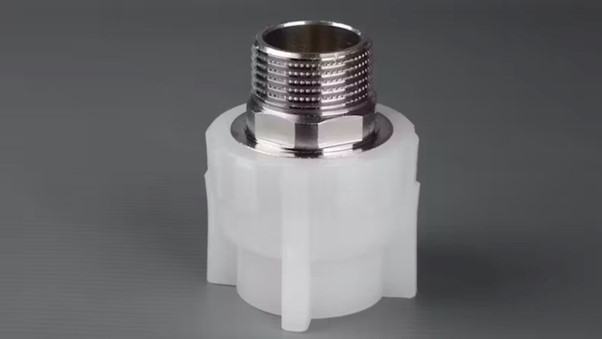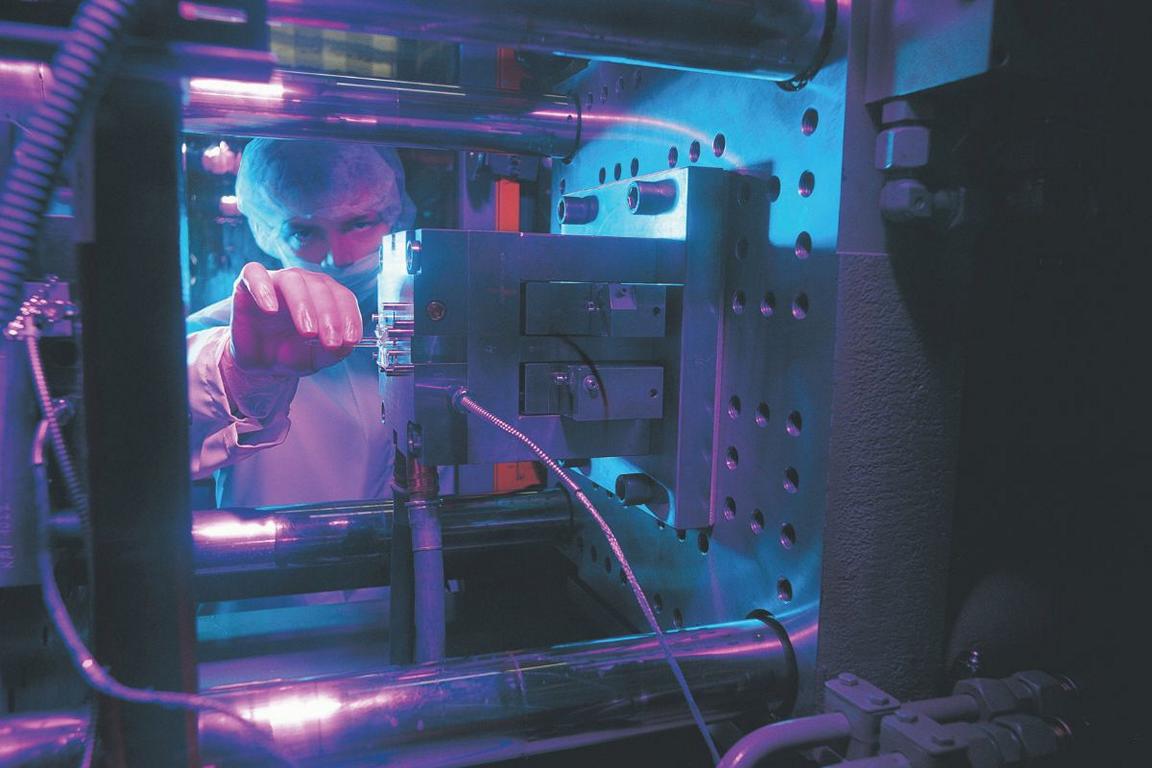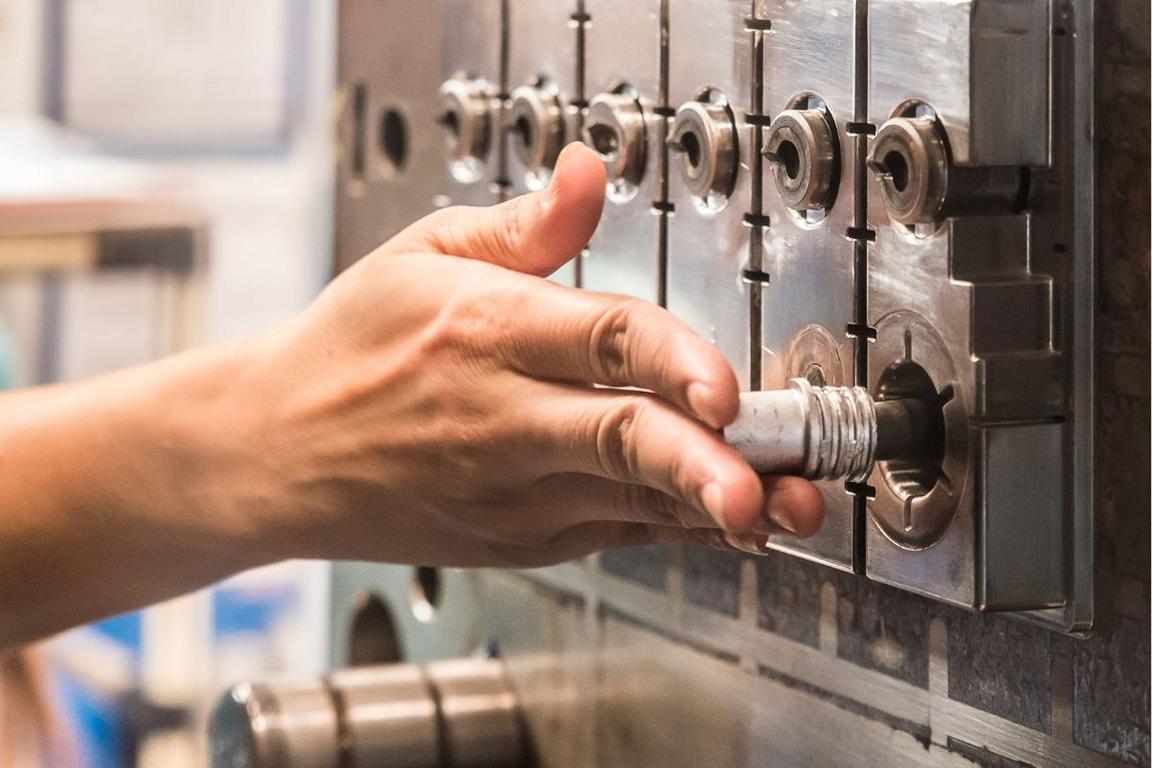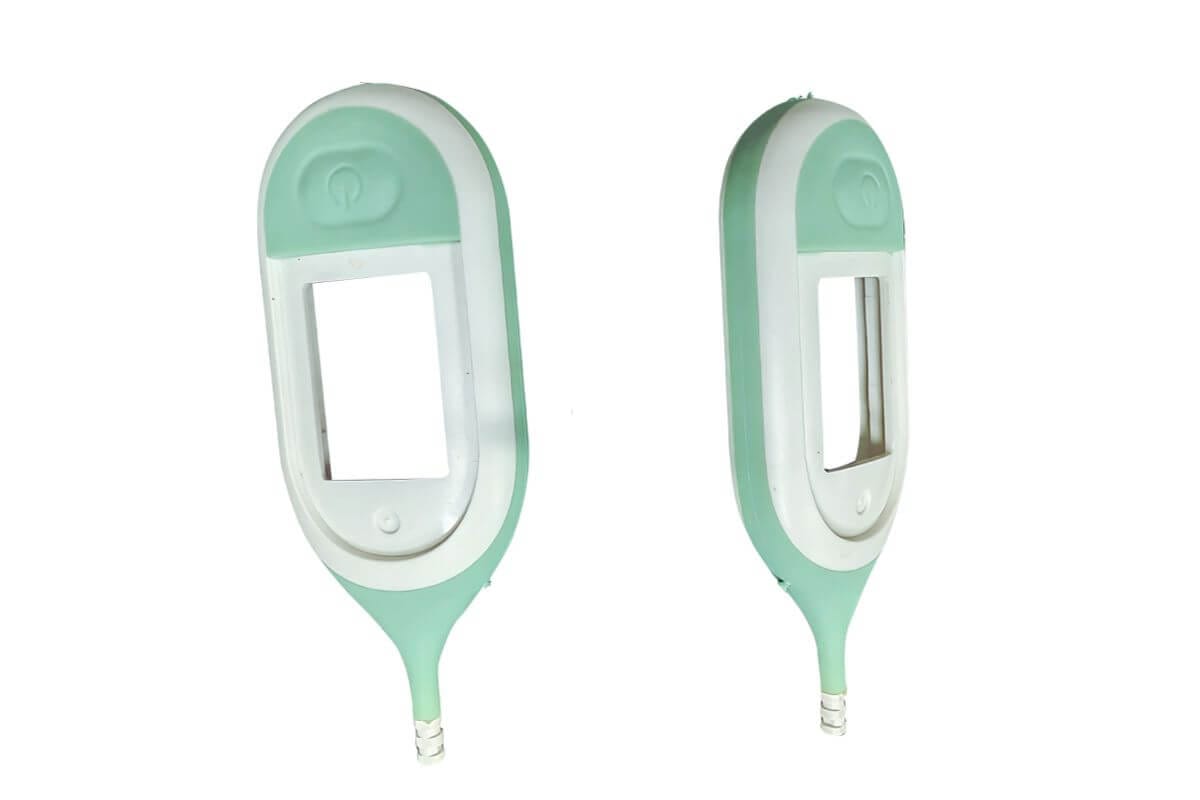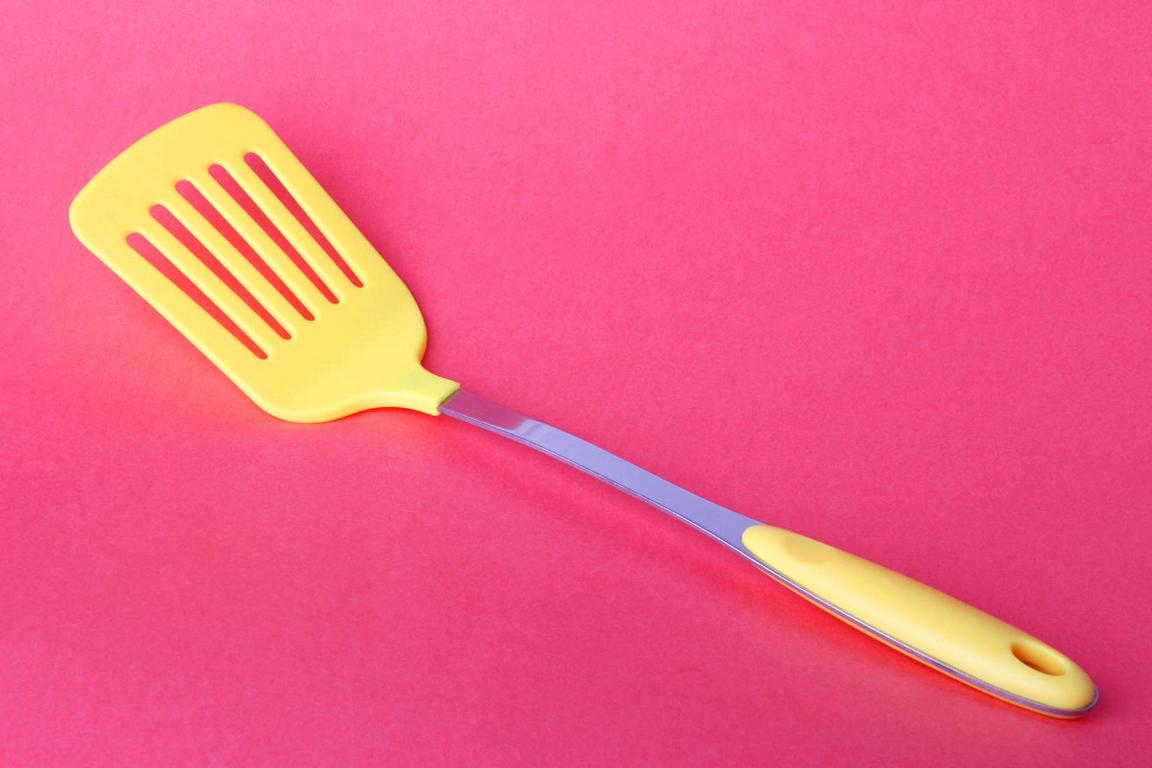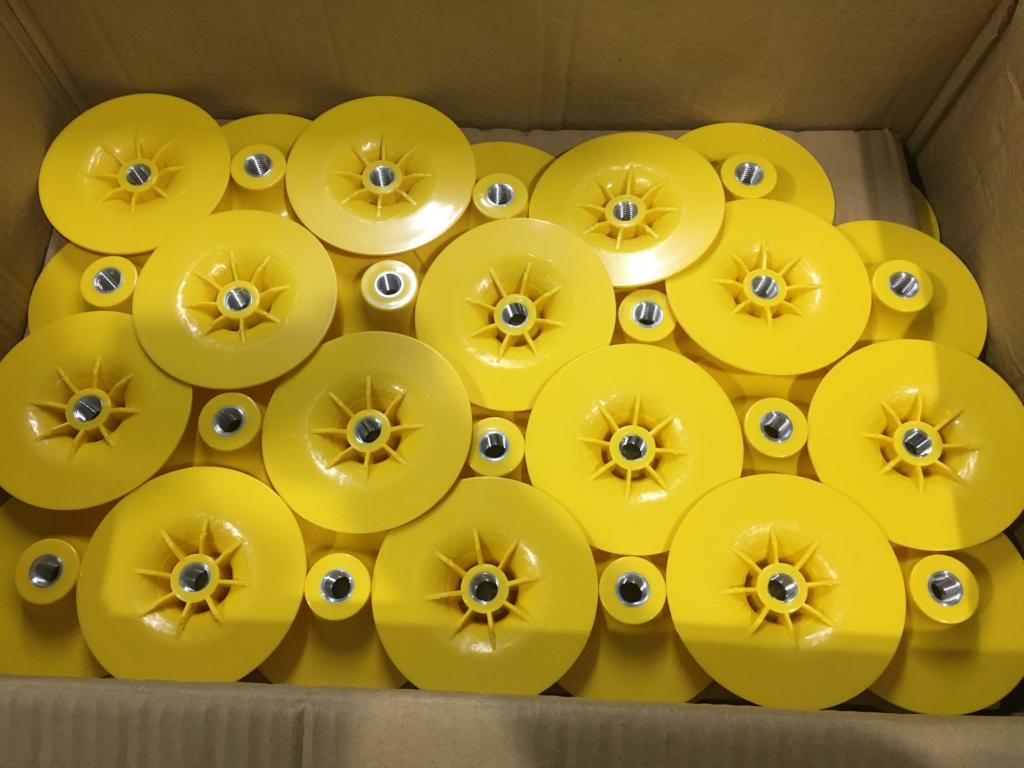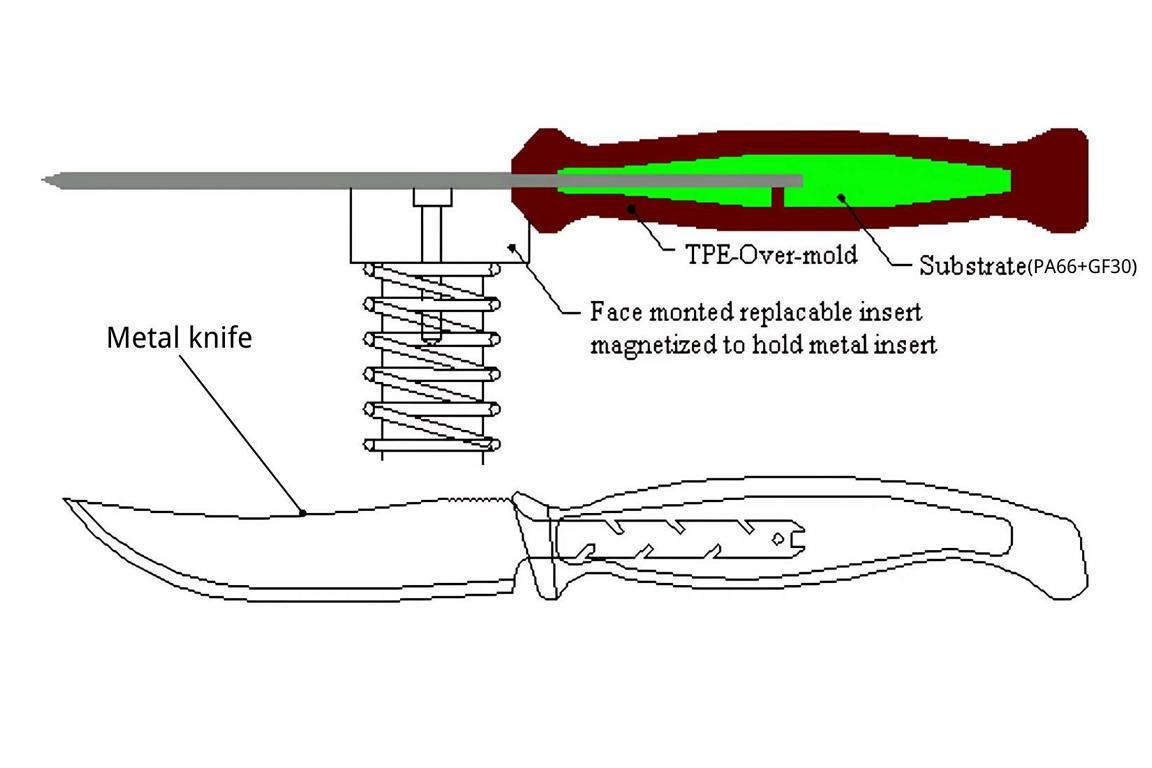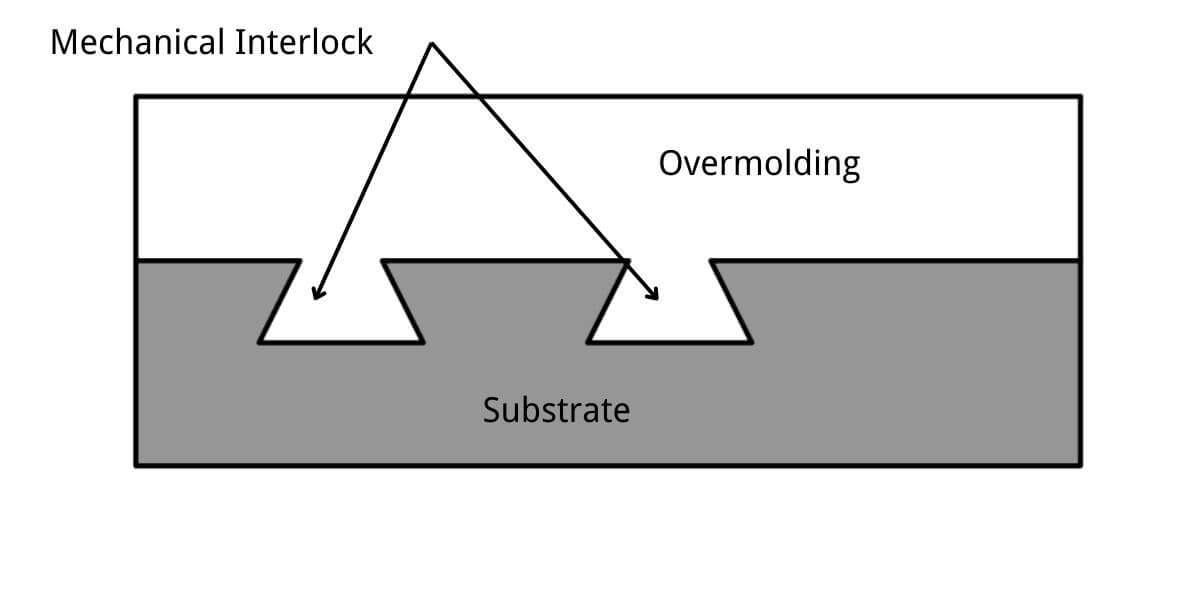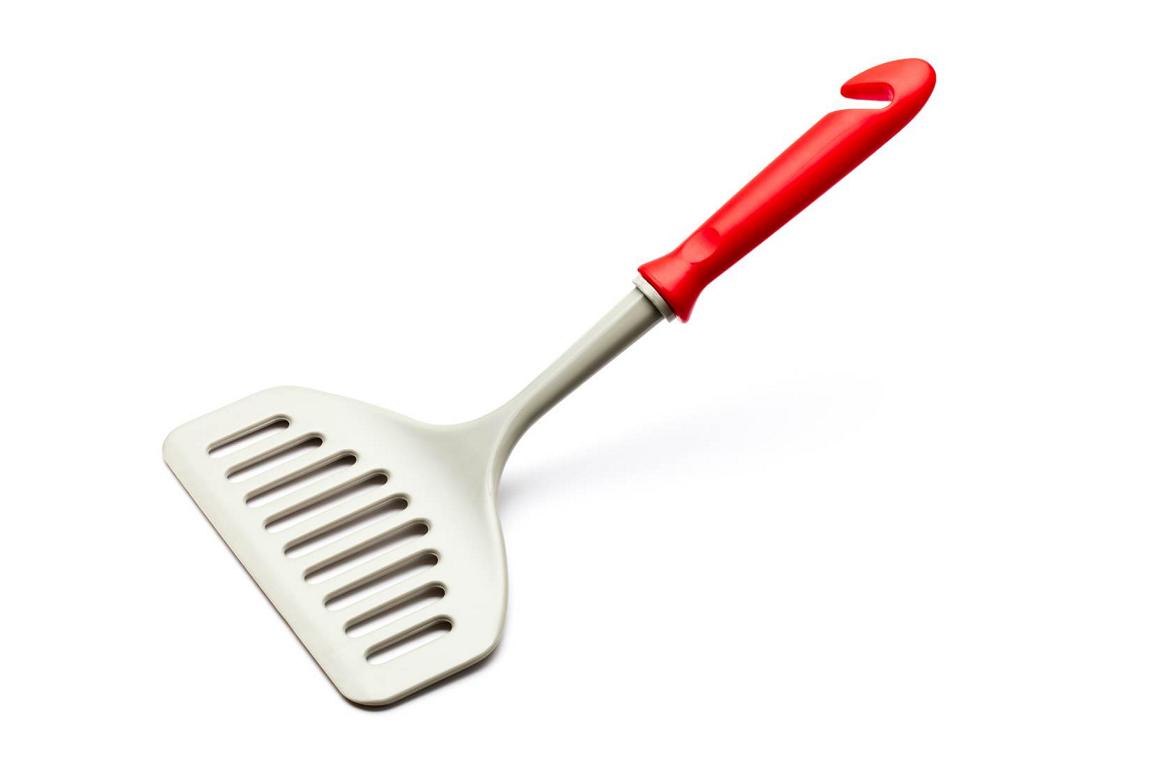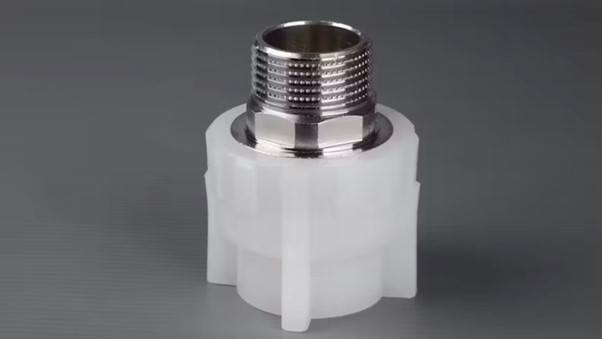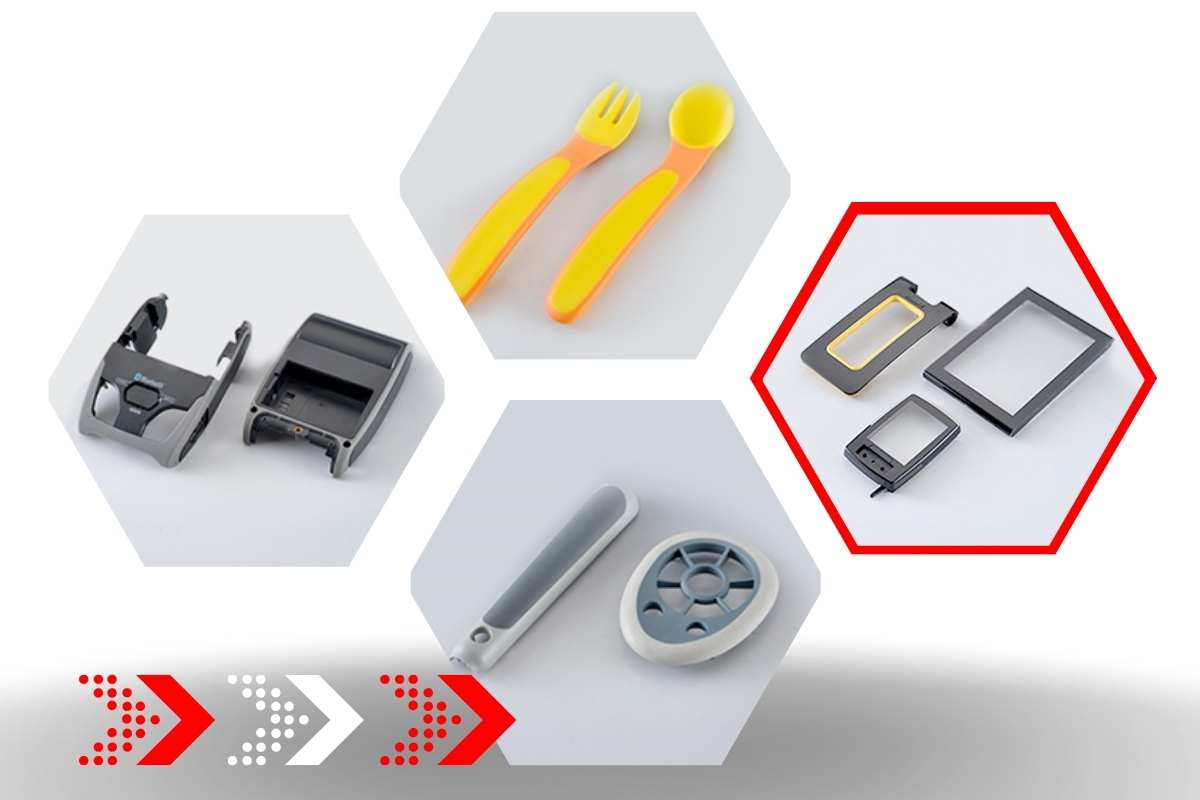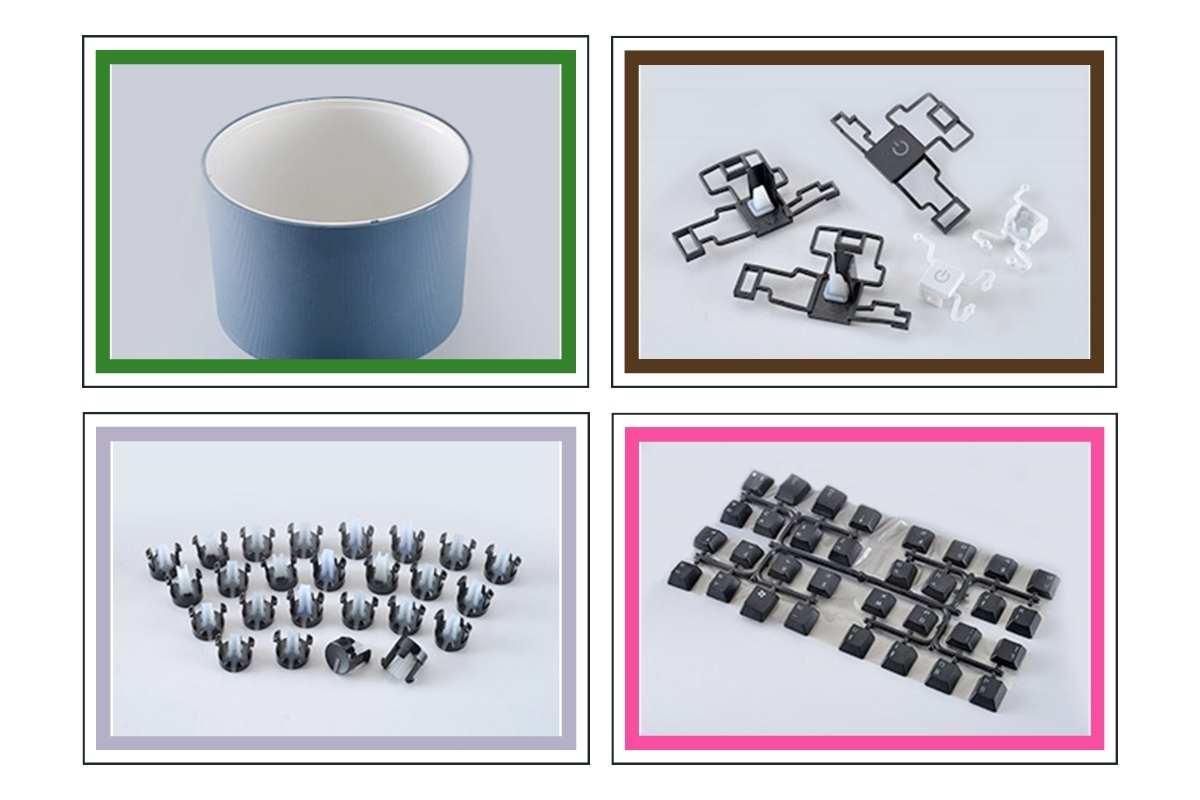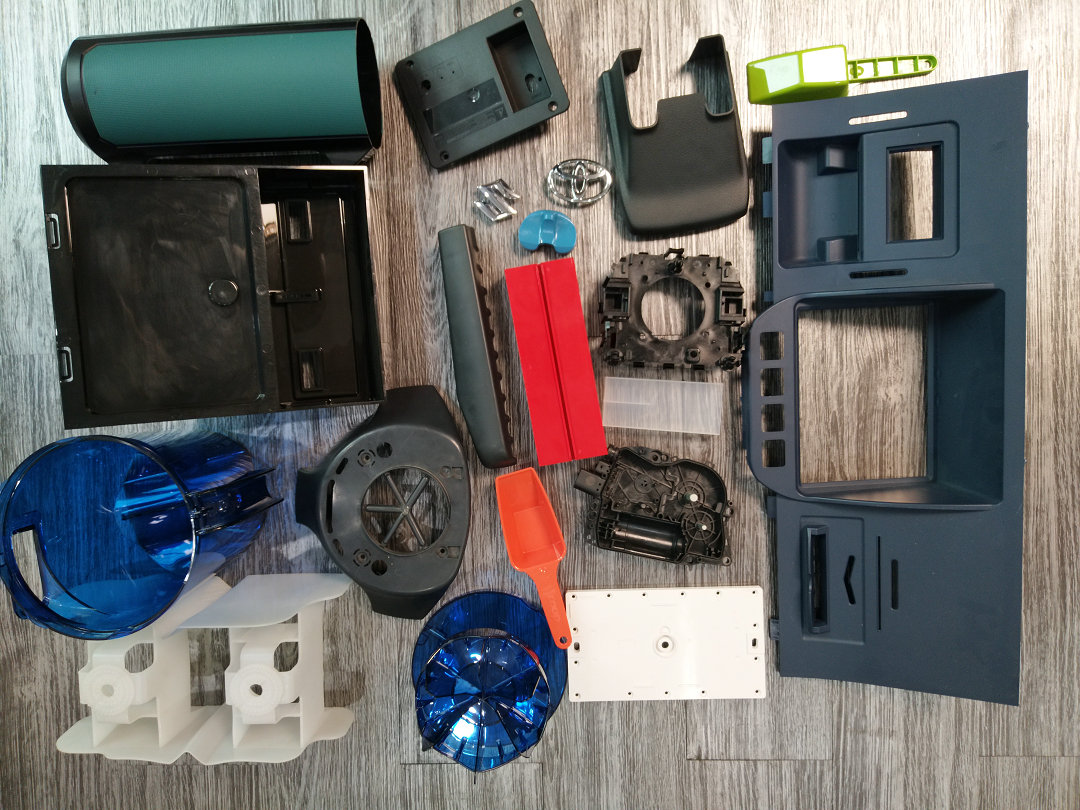Краткое резюме Разница между овермолдингом и 2k-формовкой
В то время как инъекции переформовка and 2K injection molding (also known as 2-shot injection moulding) share many similarities, they also have some key differences. See below for the difference between those two moulding processes.
Литье под давлением involves the use of a standard single-nozzle injection machine to combine two distinct types of materials into a single solid product. The overmolding manufacturing process means moving the first part (substrate part) or metal inserts to the subsequent mould (по плесени) to create the final product. You can use this technology to add a soft-touch grip to a tool handle or to create a product with multiple colors or textures.
2К литье под давлением, also referred to as multi-shot injection molding, 2-shot injection molding, or dual-injection molding, involves using a specialized 2K injection machine to simultaneously inject two or three materials (colors) into the same mold. In fact, the 2K injection machine actually has two installed moulds. Unlike overmolding, the 2K moulding machine simultaneously injects both materials, fully bonding them together once the moulding process is complete. The 2k molding process, while complex, is characterized by its speed, efficiency, and high quality.
Compared to both manufacturing technologies, 2K injection tooling offers superior quality and production efficiency. However, due to the high cost of the 2K injection moulding machine, переформовка sometimes serves as a substitute. On the other hand, the cost of an over-molded part is higher than that of a 2K injection-moulded part. However, for low volumes of 2-color moulding parts, injection overmolding can utilize any standard injection-moulding machine to produce the overmoulded parts.

При разработке деталей из нескольких материалов или двухцветных пластиков очень важно выбрать правильный процесс формования, исходя из конструктивных и производственных требований. Оба овермолдинг и литье под давлением 2K have their own advantages and disadvantages. Some of the injection moulded prodcuts can only be created with the переформовка process, while some of the injection-molded parts can only be made with the 2K injection molding process; this is depending on the plastic part geometry design.
If both moulding processes can produce the plastic parts, the 2K molding process will be the most effective for high-volume production.
Оба переформовка and 2K injection moulding can be used to create products with multiple materials or layers, but the key difference is that in overmolding, two materials are formed separately (preloading the substrate to the second mould), while in 2K injection molding, two materials are formed together in the same process (of course, a specialized machine is needed).
Что такое овермолдинг (избыточное формование)?
Overmolding, или по плесени is a manufacturing process that involves molding one plastic over another material to be merged to create a single end product. In plastic overmolding, two separate moulds are required: the substrate, which is the first tool, and the overmould, which is the second mould. Typically, the second mould is made of thermoplastic elastomer (TPE) material, but this is not always the case. If the substrate is machined metal or brass components, then we normally call this insert molding, and insert moulding only needs one mould (over mould) to finish the manufacturing process.
Материалы, наиболее часто используемые для изготовления пластика переформовка are thermoplastic elastomer (TPE), rubber, or the same material as the substrate but in different colors. Today, we will primarily focus on the технология овермолдинга в которых используются материалы TPE, широко применяемые в различных отраслях промышленности. Жесткие подложки могут быть изготовлены из широкого спектра материалов, включая полиэтилен (PE), полипропилен (PP), поликарбонат (PC), нейлон (PA6 или PA66), акрилонитрил-бутадиен-стирол (ABS), полиметилметакрилат (PMMA), полистирол (PS), полистирол с высокой ударной вязкостью (HIPS), полифениленоксид (PPO), акрилонитрил-бутадиен-стирол (ABS) или любой другой материал специального назначения, который может быть использован в качестве подложки.
Переформовка Процесс литья под давлением используется для впрыска одного пластикового материала (Over-mold) over another material (substrate). The overmolding plastic material normally uses TPE, rubber, TPU, or the same material but in different colors. Overmoulded materials will make a strong bond with their substrates, ensuring long-term durability and optimal performance in their intended environments. The use of overmolding removes the need for adhesives when connecting thermoplastic elastomers (TPEs) to hard substrates. The overmolding Эта технология упрощает процесс производства пресс-форм, снижает затраты и обеспечивает большую гибкость дизайна.

Типы овермолдинга
Types of overmolding include two-shot sequential переформовка, insert moulding, and multi-shot injection molding (2K and 3K injection moulding, or more).
Two-shot sequential overmolding
При последовательной съемке двух кадров литье пластмасс под давлением, the molding machine injects the first plastic resin into the first mold cavity (substrate mould); after the material cools and forms the first plastic shape, it then opens the tool. All of those molding processes are the same as the traditional injection moulding process.
Once the first substrates are completely finished and cooled, insert the substrate into the second mold (overmold), close the tool, and then inject the second material. The process is also the same as the traditional molding process; the difference is preloading the substrate into the cavity before the manufacturing process begins.
All of those moulding processes will be done with traditional injection machines.
Инертные материалы для литья под давлением
Накладная вставка использует предварительно отформованные вставки или металлические вставки, помещаемые в форму перед впрыском второго материала; если вставки металлические или латунные, то мы называем ее металлической вставное молдинг. This overmolding process, which we used a lot, for example, metal screw insert moulding and формовка фильтрующих вставокВ этом типе переформовка Для производства используется традиционная машина для литья под давлением, которая помещает металлические вставки в полость формы в течение одного цикла литья под давлением.
Like the below picture is showing, the insert переформовка с инертным металлом. Этот тип облицовка требуется только одна пресс-форма для литья под давлением; однако, если первая вставка изготовлена из пластика, нам понадобится дополнительная пресс-форма для первой пластиковой вставки.
Multi-shot injection moulding or 2k injection molding
Multi-shot injection molding, sometimes called 2-shot injection moulding, is also a type of overmolding. This molding technology requires specialized injection moulding machines, which have two injection units. The injection barrels can be parallel or perpendicular to each other. There will be two injection moulds assembled in this machine; one injection tool makes the substrate, and the other one is for the overmolding process.
The moulding machine injects the first plastic resin into the first cavity, also known as the substrate mould. Once the material cools and forms the first plastic shape, it opens the tool. This process is identical to the traditional injection manufacturing process. Once the moulds are open, the movable half rotates 180° without ejecting the substrate. Next, it closes the molds and initiates the second injection, also known as the overmold.
Simultaneously, it injects the first shot. Once the second cavity completes its molding process, it opens the tools again and ejects the overmoulded product from the overmold. During this process, a new substrate is generated for the second cycle.
Это полный цикл формования для процесса литья под давлением 2k.

TPE overmoulding
TPE (термопластичный эластомер) plastic materials are used a lot in the injection molding field, especially for the overmolded parts. In the переформовка market, over 80% of overmolded parts are made by Формование поверх TPE,
Формование поверх TPE is the injection moulding process where TPE (thermoplastic elastomer) is formed onto a rigid material (for example, PC, PA66, or ABS material) according to the specific requirement. The overmolded TPE will strongly bond with the first plastic and maintain its final use purpose. To prevent the TPE material from stripping off from the second material, material selection and part design are very important.
A TPE производитель овермолдинга при выборе оптимального метода изготовления деталей для литья пластмасс под давлением, выбирая между 2К-формованием и процессом овермолдинга, учитывает все необходимые факторы. К важнейшим факторам относятся производственные мощности, выбор материала, доступное оборудование и трудозатраты.
Обычно переформовка process is the most popular choice when total production volumes are less than 50K. This number is only a reference and not a definitive one because it depends on the size and complexity of the part design. For higher volume production requirements (total volume over 200,000 units), a 2-shot injection moulding process will be a better option; of course, this is still dependent on the part design because some parts can only be made with an overmoulding process; for example, the below part can only be created with the overmolding process.

В каждом TPE overmoulding or 2K injection molding process, the number one issue is to achieve maximum adhesion between the TPE and the substrate. Some TPE overmoulding may have significantly different bond strengths between multi-shot and overmolding. Even if an excellent bond is produced with two-shot molding, the same material may have a low bond strength when using переформовка. Таким образом, чтобы сделать высококачественный готовый overmolding and 2K moulding products, a thorough understanding of TPEs, part design, engineering plastics, and the specifics of the moulding process is important.
Советы по выбору материалов для овермолдинга TPE
Как мы знаем, чтобы сделать высокое качество Формованные из полиэтилена product, both TPE and substrate materials are most important, the number one factor to define the quality of overmoulded part is how good the mergeration between two matreials, if the TPE is easy to strip off from the substrate then the material will be issues, below there are some tips for meterials selestion, following thsi tips you will find the best suitable material for overmoulded part.
Толщина детали, отлитой из полиэтилена
Designers frequently request the softest TPE. They don’t realize that a TPE’s soft durometer doesn’t provide much to “cushion” below a particular thickness (usually less than 0.1mm). Thinner TPE overmoulded part feel harder—the hardness impact depends on thickness. Multiple closely spaced ribs can produce the illusion of thickness without utilizing much material. Many kitchen utensil handle use this method.
Твердость пластикового материала TPE,
Мягкость материала TPE, который вы должны выбрать при изготовлении Формование из полиэтиленаособенно TPE без толщины, которая составляет более 0,5 мм. Чтобы иметь хорошее ощущение прикосновения, вам может понадобиться протестировать различные типы материала TPE по Шору A, если нет особых требований к функциям, обычно мы используем на рынке от TPE по Шору A от 40 до 60; если слишком мало, это может привести к отрыву от подложки; если твердость слишком высока, ощущение прикосновения может быть недостаточно хорошим.
Советы по выбору материала подложки
По сравнению с материалом TPE, материалы подложки легче выбрать; большинство материалов могут быть подложками, включая нейлон/ПА (PA66 или PA66 GF30, PA6 или Пластик PA6 GF30), поликарбонат (PC), акрилонитрил-бутадиен-стирол (ABS, PC/ABS, ацеталь (POM), PMMA и так далее. Окончательный выбор материала подложки зависит от конечной цели. Если вы не уверены в выборе оптимального материала для ваших деталей, отлитых из TPE, пожалуйста, свяжитесь с нами, и мы дадим вам несколько рекомендаций.
Обработка поверхности подложки и TPE overmold
Обработка поверхности на подложке также влияет на адгезию резины TPE. Чем сильнее адгезия, тем меньше вероятность того, что она оторвется, обычно будет хорошая полировка между поверхностью слияния между TPE и подложкой, со стороны полости TPE, в такое время обработка поверхности будет влиять и на TPE overmold, иногда полировка полости TPE, TPE overmolding часть будет прилипать к стороне полости, добавить некоторые небольшие текстуры VDI улучшит это.

Советы по проектированию деталей из TPE для литья под давлением
Дизайн деталей, как уже говорилось, играет решающую роль в создании высококачественного Формование из полиэтилена изделие. В целом, конструкция детали подложки аналогична конструкции других деталей оснастки для литья пластмасс под давлением. Для получения более подробной информации, пожалуйста, обратитесь к странице проектирование пластиковых деталей для литья под давлением. But there are some factors on the merge area between the substrate and TPE overmoled area; there is no standard design for this area since different parts have different geometries, but there are some key points that you need to think about when you do the overmoled part design. Those factors will be:
Как хорошо запечатать TPE при овермолдинге и предотвратить вспышку при проектировании деталей овермолдинга:
TPE material easily exhibits flash (0.03 mm gap), and bondable TPE materials meet more stringent criteria than standard TPE polymers. The same holds true when designing parts. Unlike traditional part design, two-component part designs must account for shrinkage from two different thermoplastic materials. Both substrate and over-moulding have their own gate and runner systems, which must be tailored to the individual material properties used.
Для обеспечения оптимального времени цикла, подложки и переформовка Толщина стенок должна быть одинаковой. В большинстве случаев толщина стенок 1-3 мм обеспечивает удовлетворительное склеивание. Более толстые куски следует вырезать, чтобы уменьшить усадку, вес и время цикла. Чтобы избежать засыпки и газовых ловушек, переход толщины стенок должен быть постепенным. Добавьте радиус к острым конусам, чтобы уменьшить напряжение. Избегайте глубоких, недоступных глухих карманов или ребер. Длинные тяги должны иметь угол вытяжки 3-5 градусов для облегчения распалубки. В переформованных компаундах можно создавать глубокие подрезы, если при раскрытии формы используется продвигающийся сердечник, деталь не имеет острых углов, а эластомер изгибается при выталкивании.

Most TPE compounds have significant flow direction tool shrinkage and moderate cross-flow shrinkage. After ejection from the tool, the over-moulding compound may contract more than the substrate. This can stretch the substrate, usually in the overmolding material’s direction. This is especially true for long, thin parts or components with a low-modulus substrate or one thinner than the по плесени. Для смягчения этой проблемы используйте более высокомодульные материалы подложки и ребра жесткости. Помогают более тонкие покрытия и более низкая твердость литьевых форм. Также может помочь перемещение затвора, чтобы повлиять на поток TPE.
Если вы можете усовершенствовать конструкцию, чтобы обеспечить более плотное соединение материала TPE с основой, например, увеличить площадь поперечного сечения, без ущерба для функциональности или внешнего вида, это будет полезно. Ниже приведен один из примеров советов по проектированию деталей, изготовленных методом овермолдинга.

Избегайте создания слишком большого количества разделенных областей на Деталь для литья под давлением из полиэтиленаЭто может усложнить производство пресс-форм и процесс формования. Особенно много областей разработано в области линии разделения; это будет трудно решить проблему вспышки полностью, когда вы разрабатываете деталь из TPE с избыточной формовкой, разрабатывая как можно более простую конструкцию, если только она не выполняет какую-то функцию.

Советы по изготовлению пресс-форм:
Когда мы разрабатываем литьевую форму для переформовка детали, для первой пресс-формы (подложки) мы добавим коэффициент усадки в соответствии с коэффициентом усадки пластика, но для over mould (второй инструмент), мы не будем добавлять тариф на впрыск через пресс-форму.
Стоимость формовки
Базовая стоимость переформовка не является фиксированным числом, которое будет одинаковым для каждого приложения. Его значение может варьироваться в пределах от 1 до 10 долларов.
Это очень широкий ценовой диапазон. Правильная стоимость меняется в зависимости от нескольких компонентов, участвующих в процессе овермолдинга. Этими факторами, влияющими на стоимость, являются:
Оборудование для литья под давлением
Первоначальная стоимость оборудования для литья под давлением может сильно меняться в зависимости от его применения и типа.
Существует малогабаритное оборудование для литья под давлением, которое предприятия держат у себя дома. Большие машины для литья под давлением используются, как правило, поставщиками услуг и теми, кто занят в крупном производстве с большими объемами продукции.
Профессиональные промышленные переформовка стоимость оборудования составляет от $50 000 до $200 000. Возможны расходы на доставку. Эти машины не для любителей и хоббистов, поскольку им требуются квалифицированные операторы.
Overmold manufacturing costs
В то время как переформовка Оборудование - это единовременная инвестиция, создающая по плесени according to each custom design is an additional cost, and each single product design will require a unique over mould. It is an expense for every different part produced. over mold manufacturing costs are one of the most vital cost factors for overmoulded parts.
This over mold cost can vary depending on the part design, part size, and quality required to create the moulds. Generally, three factors are employed for this objective, which are listed below:?
Сложность конструкции
Highly complex designs that requires complex overmold, this often include features like multiple cavities, intricate geometries, sliders, and lifters. These elements require advanced engineering, extended development time, and additional manufacturing cost, all of which increase overmolding tooling costs.
Размер детали
Over mold is the same as other injection moulds; a large size will require a large mouldbase and moulding machine, which will increase the over mold cost and unit moulded part cost.
Расходы на оплату труда
Over mold is normaly hard than normal mold, because it needs perfect mold fitting, specailly is TPE overmolded on the substrate, TPE is very easy to go flash, the skilled technicians are needed to monitor machines, perform quality checks, and mold fitting operations, which adds to labor costs,
Since the the overmolding typically involves manual or robotic pre-loading the substrates into the cavity, the molding cost will be much higher than traditional molding cost.
Waste cost
Material waste from sprues, runners, and rejected parts adds to costs. Overmolding will have more reject costs than traditional costs; if one part is rejected, that means the substrate is wasted as well. Employing hot runner systems can minimize waste by eliminating runners, but these systems come with higher initial investment costs.
Final summarize for the overmoulding cost
Если вы ищете литой parts for your custom injection moulding parts, then you do not need to pay any cost on the injection molding equipment, because your supplier should have this, but you need to pay for the over mold cost, over-moulding process cost, materials cost, packing cost, and so on. If you want to know the price of your переформовка Пожалуйста, свяжитесь с нами, и мы предоставим вам цену в течение 24 часов.

Metal insert moulding
Как снизить стоимость овермолдинга
Переформовка является предпочтительным процессом производства благодаря своей экономичности и надежности.
While the process is affordable compared to its alternatives, you can further decrease the costs. For that objective, here are some points that you need to take into account:
Оптимизация CAD-проекта
К одной детали можно подойти с помощью различных CAD-проектов. В любом случае, не каждая идея дизайна является идеальной. Некоторые проекты для одной и той же детали могут привести к потере времени и ресурсов. Поэтому упрощение сложности детали с помощью эффективного проектирования в САПР обеспечивает оптимальное использование ресурсов.
Уменьшение размера детали
Большие детали - не всегда отличные детали. Когда размер деталей увеличивается, возрастают и расходы на пресс-формы, необходимые для их изготовления. Если тот же процесс можно осуществить, уменьшив размер детали, стоит сделать выбор в пользу этого.
Спасение из-за форм
Make full use of the over molds by reusing them for many applications. You cannot just use the same mold for the same part but also for similar parts as well, when you design similiar part you can even use interchangeable cavity and core to save the tooling cost.
Using DFM (Design for Manufacturing) Analysis
DFM означает "проектирование для производства". DFM в овермолдинге означает производство детали, которая отвечает целям заказчика и не выходит за рамки оговоренного бюджета.
A thorough DFM analysis helps align the design with manufacturing capabilities, for examle, ensure the design meets functional requirements without unnecessary complexity, and use lower-cost thermoplastic elastomers (TPEs) compatible with the substrate. which can lower down costs. Go to проектирование для производства страницу, чтобы узнать больше.
Reduce Cycle Times as Much as Possible
There is a direct correlation between reducing cycle times and improving operational efficiency and costs:
Optimised Cooling Channels: better cooling linee design in the mold can reduce the amount of time needed for cooling and increase the quality of the part, this is same to traditional mold.
Decrease the amount of material waste
Efficiency in the use of materials is a primary factor in cost reduction, for high volume products requrirement, use hot runners in order to reduce the amount of scrap material resulted from sprues and runners.
Incorporating regrind material while ensuring that its percentage does not damage the quality of the item is an important step in the recycling process.
Make sure perfect mold fitting can reduce the waste as well, use stable injection molding machine can reduce the waste cost.

Оба переформовка и 2k литье под давлением are very similar processes, sometime both moulding processes can work on the same part, but something can only be created with single литье под давлением или 2K литье под давлениемЭто полностью зависит от конструкции детали.
Преимущества литья под давлением
- По сравнению с литьем под давлением 2K, переформовка is easier to make. You can use a normal injection machine to make two or three different colors in one molded part or two or three different materials in one end part.
- Для некоторых проектов по изготовлению двухцветных деталей в небольших количествах вам не нужно инвертировать или нанимать 2K-машину для литья под давлением; с помощью литой Процесс является наилучшим и наиболее экономически эффективным способом удовлетворения требований заказчика.
- Он увеличивает разнообразие дизайна и возвышает конечный продукт в различных композициях материалов.
- При снижении затрат на сборку уменьшается количество вторичных операций или процессов, выполняемых на конечных изделиях. Это снижает стоимость рабочей силы. Кроме того, после изготовления больше не возникает никаких затрат.
- Детали обладают высокой стабильностью и прочностью, поскольку после механического сцепления они становятся единым целым.
- Продукция литой Пластик обладает высокой устойчивостью к вибрациям и ударам благодаря идеальной структуре полимерных смол.
- The plastic moulded parts are more reliable because there is no bonding at the production stage.
- Конечные изделия соответствуют желаемым стандартам, например, имеют привлекательный дизайн и прочные компоненты.
Недостатки литья под давлением по сравнению с формованием
- Так как формовка process involves moving the first substrate part to another over mold, the tolerance is not as good as in the 2K injection molding process.
- Производственная мощность не столь эффективна, как при литье под давлением 2K, поскольку для вставки подложки в инструмент для литья под давлением требуются роботы или ручной труд. Это требует времени, а параметры формовки иногда не стабильны, особенно если в одном инструменте находятся две или более подложек. Это приведет к дополнительным проблемам и увеличению количества отходов, в результате чего их будет вдвое больше (из подложки и переформованного материала).
- С процесс формованияВ плане совместимости пластиков выбор меньше. Некоторые материалы могут плохо скрепляться между собой или не выдерживать высоких температур и давления при литье под давлением.
- There are no secondary practices carried out on the end products of over-moulding. When the plastic material becomes cold, activities and adjustments come to a complete halt.
- In cases where products are scarce, it is expensive to run such an operation. Sincerely, you need someone to put the substrate into over-mold, so the cycle time and production cost are increased accordingly.
- Для процесса литья под давлением обычно требуется две пресс-формы: одна для подложки, другая - для формы, поэтому первоначальная стоимость оснастки будет выше.
- Переформовка это более сложный процесс, чем традиционное литье под давлением, требующий точной координации между двумя системами впрыска и правильной конструкции пресс-формы.
- Если в процессе литья под давлением возникают проблемы, то их устранение может быть сложнее, чем при традиционном литье под давлением.
Что такое литье под давлением 2k? (Двухкомпонентное литье)
Двухшовное литье под давлениемили 2K литье под давлением, - это производственный процесс, используемый для создания двух цветов или материалов в одном пластике. Технология двухкомпонентного литья позволяет соединить два материала или два разных цвета материала в одной пластиковой детали с помощью машины для литья под давлением 2K.
Процесс химического соединения, задействованный в этом процессе, очень важен, поскольку он способен объединить два или более материалов в одну деталь. При использовании технологии литья под давлением 2K выбор материала будет важным фактором, определяющим успех проекта или нет.

Преимущества литья под давлением 2K
2K литье под давлением обеспечивает ряд преимуществ по сравнению с традиционным литьем под давлением из одного материала. Вот некоторые из этих преимуществ:
Экономически эффективный
The 2K injection molding process combines two compatible materials in a single machine cycle. It begins with the first material being injected into the primary mold. The moving half then rotates 360 degree, and close to eject the plastics for the second material to be overmolded in the secondary cavity. in the maintime the first injection is working synchronous.
The use of adhesives or further assembly is not necessary for this seamless technique, which guarantees the high quality bonding between the materials.
Because the method uses only one cycle instead of separate machine cycles, it costs less for any production run and needs fewer employees to make the end product while delivering more items per run. It also ensures a powerful bond between the materials without the need for additional assembly down the line.
Повышение эффективности
Двухшовное формование permits multiple components to be created with one tool, decreasing the amount of labor required to run your parts and eliminating the need to join or weld components after the molding process.
Лучшее качество
Two-shot is carried out within one tool, permitting lower tolerances than overmolding processes, a high level of accuracy and repeatability, and reduced scrap rates.
Solve the part design issues
Двухшовное формование позволяет создавать сложные конструкции пресс-форм, включающие различные материалы для обеспечения функциональности, которая не может быть достигнута с помощью процессов последующего формования.

Недостатки литья под давлением 2K
2К литье под давлением У него много преимуществ, но, как и у всего, есть свои плюсы и минусы.
Недостаток 2К литье под давлением Потому что для изготовления 2K-инжекционной оснастки требуется две формы, первая и вторая (поэтому мы называем ее двухшовной), а изготовление 2K-инжекционных форм сложнее, чем изготовление двух отдельных традиционных форм, потому что эти две формы будут работать вместе в одной машине (двухшовной машине для литья под давлением), поэтому нужно две формы, чтобы переключаться без проблем.
Кроме того 2К литье под давлением Для этого процесса необходимо использовать 2K-инжекционную машину, что также делает ее более дорогостоящей и требует специального технического оператора для настройки машины. Это также более высокая стоимость по сравнению с традиционной инжекционной оснасткой. В конечном счете, мы возмещаем 2К литье под давлением Снижение затрат за счет сокращения трудозатрат и расходов на сборку, так как отпадает необходимость в ручном нанесении, например, пломбы. Это исключает этап сборки.
Еще один недостаток литья под давлением 2K заключается в том, что оно затрудняет вторичную переработку пластиковых изделий, поскольку зачастую собираются два разных пластика. Даже если пластики "из одной семьи", качество возвратных потоков будет очень низким, что затрудняет повторное использование пластика для высокостандартного применения.
Как выбрать услуги по овермолдингу и литью под давлением 2K
You may have questions about when you need to use over moulding and when you should use the 2K injection molding process. Here are some simple suggestions:
- If the quantity of the overmolding or 2K molding part is only a few thousand or ten thousand, it is recommended to use the overmolding process instead of 2k moulding process as it can significantly reduce mold costs.
- If you require more than 500,000 parts, 2K injection molding is the most cost-effective manufacturing process. This is due to the high labor costs associated with overmolding and the high initial cost associated with 2K moulds, two-shot injection moulding machines, and related equipment.
- Для одних деталей единственным методом является овермолдинг, для других требуется процесс двойного литья под давлением. Это зависит от структуры конструкции детали. Если вы не уверены, отправьте свои данные на адрес info@plasticmold.net. Мы можем проверить это для вас и предоставить цену для справки.
Looking for over moulding or 2k injection molding service?
Sincere Tech - одна из лучших компании по литью под давлением в Китае. Если вы ищете переформовка, insert moulding, 2К формовкаили любые другие формы на заказ, отправьте нам ваш 3D дизайн чертеж и ваши требования; мы никогда не будем делиться вашими данными с кем-либо еще. Мы готовы подписать NDA документ, чтобы обеспечить безопасность вашего проекта.
We will offer you the most competitive price for high-quality overmoulded parts, 2K tooling and moulding, plastic tooling, and plastic parts for the long-term business relationship, and we will suggest the best injection manufacturing process for your products.
More than 18 years of experience providing plastic mold making and custom mold services in overmolding, 2K moulding, die casting, machining, and so on, plus 18 years of fluent technical English communication (technical English communication is very important to work with worldwide customers).
Принимаются небольшие заказы. Основные экспортные рынки: Азия, Австралия, Центральная и Южная Америка, Восточная Европа, Северная Америка, Западная Европа и весь мир.
